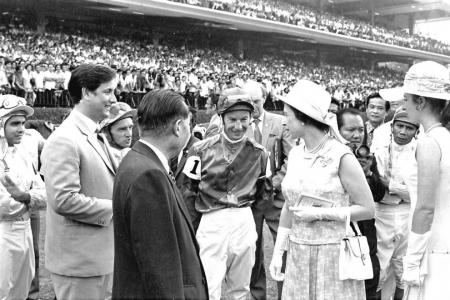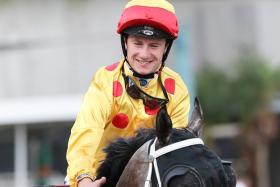S’pore horse racing rides sadly into sunset, leaving great tales to regale grandchildren
Shock. Disbelief. Anger. Sadness. There were no good feelings when it became official that racing in Singapore would cease in 16 months’ time.
Like most racing fans, I had heard the news on Monday evening and it was a good enough reason to make tracks to my local pub for a Happy Hour drink.
I was hoping it would help ease the numbness I felt.
At the pub, there was nothing happy about the evening.
I was not alone. My “kakis”, seated at the bar, had also heard the news. That the Singapore Turf Club at Kranji would cease operations after Oct 5, 2024. They, too, were gutted.
And they were not diehard punters. Or big-time gamblers. They were regular blokes who, on race day and for years, enjoyed having a flutter on a horse whose name appealed. Or whose racing silks were in the wife’s favourite colour.
Silly, frivolous stuff like that.
If the news killed our mood, we wondered just how it affected the people directly involved in the day-to-day stuff at the racecourse.
We felt sorry for those who were going to lose their jobs. Riding boys. Grooms. The odd-job man. Even the local farrier.
Most of them did not have much of an education. Their jobs had been handed down through generations. Where on this small island were they ever going to find work with horses?
We talked about the expats. The trainers and their staff. The jockeys. Some had taken up Singapore citizenship and sent their kids to do national service, believing – so wrongly – that they had a job for life and a good future in their adopted country.
For them, it is now back to the drawing board and it is not a pretty picture.
We tried to lighten things by talking about the “old” trainers and jockeys.
There was Ivan Allan who in 1983 took bullets to the chest from, what we reckoned, was an angry bookmaker.
Thankfully, he survived and was able to continue his battles with other legendary trainers like Teh Choon Beng and Malcolm Thwaites, Colin Tulloh and the van Breukelens – Rinus, Eddie and Marinus.
Allan would go on to make a name for himself, primarily with a horse named Jumbo Jet. The son of Pavot ruled Bukit Timah in the early 70s. He died in 1982 at the age of 15 and was buried near his stall at Allan’s stable.
Years later, when the Kranji Racecourse was being built, there was talk of displaying Jumbo Jet’s skeleton at racing’s new home. Much like that beloved whale at our National Museum.
So the exhumation began. I watched as they dug up his grave, trying to retrieve his skeletal remains. But alas, those remains were not in good enough condition to be displayed.
Like other sports, racing has its stories and its characters. Good, bad and shady. And we have seen them all.
There was this trainer Henry Tan, who “drenched” his horse to prevent it from winning. Drenching is having salt water pumped through a horse’s nostril into its stomach. It was beyond cruel.
Then there was the case of another trainer who, in 1979, attempted to “lose” a race by tossing in a “ringer”, or a lookalike.
It backfired. The “ringer” won and the ruse was quickly discovered. The horse which was supposed to run was a gelding.
But the ringer had his family jewels intact. The stewards did not miss it. The trainer was disqualified for life.
While all of that is in the past, they are still great stories to tell our grandkids.
Kranji had the pleasure of having fine, upright trainers who kept the game going. Guys like Pat Shaw, Mark Walker, Michael Freedman and the late Laurie Laxon laid the groundwork. Others tried to follow suit.
Today, we have Shane Baertschiger. He has been here so long that he is as local as the guy having kaya toast at the kopi tiam.
He arrived in the early 90s when he relocated from Australia with his father, Don. He would take over training duties from his father in 2012.
Right now, the 50-year-old is married and has three kids – all are Singaporeans.
He cut ties with Australia a long time ago and, like many other foreign trainers, it will be difficult – if not impossible – for them to uproot and resume work elsewhere.
We felt sorry for guys like Michael Clements, Stephen Gray, Steven Burridge and others. This has been home. Where do they go from here?
We talked about the jockeys. Back in the good old days, we looked up to riders like Glynn Pretty, George Podmore and Terry Lucas.
They were like pop stars to us starry-eyed racegoers. Same too, local riders like Moses Lee, Leslie Khoo, Martin Sng and Saimee Jumaat. They had a cult following. Lee retired in 1986, Khoo and Saimee continued to work at the club and Sng died in January.
More recently, our heroes have been jockeys like Manoel Nunes, Corey Brown, Ronnie Stewart, Vlad Duric and Glen Boss.
But the one who put Singapore on the world racing map and who must count Kranji as his launch pad is Brazilian Joao Moreira.
He arrived in 2008 and he was iconic, like John Travolta swinging that can of paint while strutting along in Saturday Night Fever. Even if you did not know where Moreira was from, you knew – just by seeing him on a horse – that he had arrived.
In September 2013, the “Magic Man” rode eight winners from eight rides at Kranji.
The racing world sat up and took notice, of Moreira and the Singapore Turf Club.
We remembered the big races staged by the club – the Singapore Gold Cup and the SIA International Cup.
I watched my first Gold Cup race in 1962 when I was 13. Of course, I could not get into the clubhouse, so I took in the action from a hillock overlooking the home turn. I knew the spot from my evening romps with my brothers and sisters.
Yes, we lived nearby – but that is another story.
I watched as a horse named Water Scout took command of things to romp home under a jockey named S. Khamis.
More than any other Singapore race, the Gold Cup has been held 93 times beginning in 1924.
There was a break between 1942 and 1947 because of the war. It returned in 1948 and, like a good wine, it got better asit got older.
As for the SIA Cup, it was perhaps the best sporting idea anyone ever had. It produced astonishing theatre and it put Singapore on the world racing map.
For once, the crowd at Kranji came to watch the race and the crowning of the winner. For one brief, shining moment, the punt became secondary.
It had its first run in 2000 and oh, how we cheered when the hometown horse Ouzo picked up the big prize.
Alas, just when it was gaining a foothold on the world stage, the powers that be decided that it had served its purpose and the race was discontinued after 2015.
It was sad but, as we now know, sad things do happen in this noble sport.
Yes, over our beers, we rehashed old gripes about the death of the SIA Cup but soon decided to put it behind us.
Instead, we drank a toast to the humble horse.
Selfishly, my heart truly went out to them. The hundreds of them now stabled at the club.
Then again, horses were always a big part of my life. As a kid, my family home was within walking distance of the club at Bukit Timah. The track ran around a valley which was my playground.
I visited the stables. I got to know the horses and, by my 18th birthday, I had taken the next step and was competing in races as an amateur rider.
The love affair continued and, in 1975, I was covering the morning gallops for the now-defunct New Nation newspaper.
Those Bukit Timah days were great and I will never get tired of the smell of sawdust and horse feed.
Yes, even now, there is nothing more majestic than the noble horse. I remember the great ones from Bukit Timah.
Horses like Jumbo Jet, Paititi Gold, Star Prince and Saas Fee. And, more recently, Rocket Man.
They are etched in our memory. Their stories never grow old.
Then I wondered, with the death knell having sounded, what was going to happen to the rest of them now stabled at Kranji?
Current champions like Lim’s Kosciuszko, Super Salute and others need not worry.
By being as good as they are, they will easily find homes in other racing jurisdictions where they will live out their lives in comfort.
But I worry for the majority of the 700-odd horses currently stabled at Kranji. The Class 5 plodders who are getting long in the tooth. Those bread-and-butter horses who have given us so much pleasure. The honest brawlers.
This is not Australia or New Zealand, where a racehorse can be retired and sent to a farm or someone’s sprawling backyard to live out their lives.
The majority now at Kranji will not be so lucky. Their fate is uncertain, and that is upsetting.
As is the thought of us having to reluctantly say goodbye to a much-loved sport.
A sport which, at one time, was part of our nation’s identity.
That night, we left the pub early. News of racing’s demise had left a vile taste in the mouth and a sick feeling in the stomach.
We hoped that a good night’s sleep would help make things better.
Who were we kidding?
Get The New Paper on your phone with the free TNP app. Download from the Apple App Store or Google Play Store now


